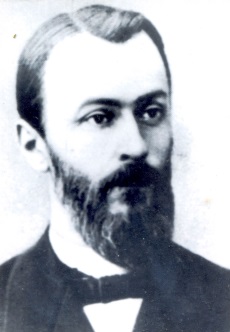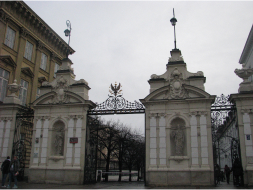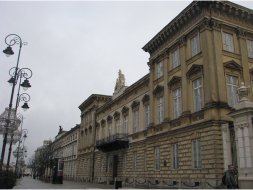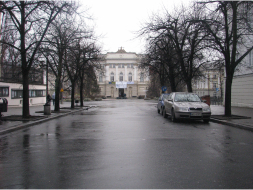Ivanovskiy Institute
 Dmitry Iosifovich Ivanovsky
Dmitry Iosifovich Ivanovsky
(1864-1920 гг.)
Biography. Summary.
Dmitry Ivanovsky graduated from St. Petersburg University in 1888 and, after graduation, started working at the Chair of Botanics of the same university.
He was an assistant at the Botanical Laboratory of St. Petersburg Academy of Sciences (from 1890), a privat-docent in St. Petersburg University (1895–1901), a professor in the University of Warsaw (1901–1915), and a professor in Don University (from 1915).
Scientific work. Summary.
Having started studying tobacco diseases in Bessarabia and Nikitsky Botanical Garden in 1887, Dmitry Ivanovsky distinguished between the so called wildfire and the mosaic disease previously mixed up (together with V.V. Polovtsev). He found (in 1892) that the agent of the latter, unlike bacteria, was not seen through a microscope with the highest magnification, went through porcelain filters, and did not grow in regular substrates. He found crystal inclusions in the affected plants' cells (Ivanovsky crystals) and, therefore, opened a special world of disease agents later called "viruses". Dmitry Ivanovsky considered them the smallest living organisms. Moreover, Dmitry Ivanovsky published works on the specifics of physiological processes in diseased plants, the oxygen impact on yeast fermentation, the state of chlorophyll in plants, its resistance to light, the significance of carotene and xanthophyll, and the microbiology of soil.
Path of life.
Russian scientists Dmitry Iosifovich Ivanovsky was born on November 9 (October 28 under the Julian calendar), 1864 in a multi-child family of a public servant in the settlement of Nizy of Luga district of Saint Petersburg Governorate.
After the father's death, the family was granted a small pension in St. Petersburg. In spite of the tight financial situation, Dmitry managed to enter a gymnasium at government expense and finished it with distinction. Having successfully passed the required exams, he was enrolled in St. Petersburg University (the Department of Physics and Mathematics), graduated from it in 1888, and started working at the Chair of Botanics of the same university. From 1890, he was an assistant of the Botanical Laboratory in St. Petersburg Academy of Sciences.
As early as being a student, during a field trip to tobacco plantations of Bessarabia and in the Nikitsky Botanical Garden, he started studying tobacco diseases. In September 1887, he published hist first report where he showed that a tobacco disease was caused by several reasons at a time. For the first time in the research literature, he distinguished between the wildfire (a fungus disease of tobacco) and the mosaic disease of leaves. Then, he set up experiments to repeat Mayer's trials with paper filters. He conducted that work after graduation from the university and start of his work at the Chair of Botanics.
By 1890, Chamberland porcelain filters became customary. Unlike paper ones, they provided a guaranteed pore size. Using those filters to repeat Mayer's trials, Dmitry Ivanovsky proved that a known tobacco disease – tobacco mosaic – is caused by some agent easily going through such bacterial filters. Impossibility of bacterial contamination was proved, meaning that the infection agent had a smaller size than the smallest known living organism. From the very beginning, Ivanovsky suggested the "corpuscularity" of the disease agent – he objected the supposition of its humoral nature, as the ability to contaminate young tobacco leaves was retained after multiple (up to 10 times) passaging of contaminated plant sap passed through the filters to healthy plants. This proved that the agent being filtered was capable of reproduction and was not just a chemical compound causing changes in the leaves. Based on the filter pore size, Dmitry Ivanovsky suggested that the microbe causing the disease was a bacterium of a much smaller size than the one of any of then known pathogenic bacteria. He managed to show presence of the "bodies" (crystals) later named after him under the microscope.
In 1892, he summarized the available data and the results of his experiments in the report called On Two Tobacco Diseases presented in the Academy of Sciences on February 14 (under the Julian calendar). In September 1892, the report was published in the Academy's bulletin as an article. In 1894, the abstract of On Two Tobacco Diseases was published in Holland in the German language. To explain the obtained results Dmitry Ivanovsky assumed that the reason of the disease was a very small microbe of a non-bacterial nature. In 1903, a brochure by Ivanovsky was published in German setting forth the general results of tobacco studies. By 1898, After long disputes with Ivanovsky regarding the agent's nature (living or non-living), M. Beijerinck published a note where he withdrew his version that it was a chemical compound (solution) and agreed with Ivanovsky regarding the corpuscular (material) nature of the "virus".
The research effort on the tobacco mosaic disease did not prevent the young scientist to improve his knowledge in other domains of science. Under the supervision of A.E. Beketov, A.S. Famintsyn, and K.Y. Gobi, he was studying plant physiology and microbiology. In 1895, he defended his master's thesis and, as a privat-docent, started giving lectures in physiology of the lowest organisms and, starting from 1896, in anatomy and physiology of plants in St. Petersburg University. From 1901, he was an extraordinary professor and, from 1903, an ordinary professor in the University of Warsaw.
Dmitry Ivanovsky studied the yeast fermentation process and the impact of oxygen and chlorophyll and other pigments of green leaves involved in photosynthesis on it. He also had some known works on agricultural microbiology. Ivanovsky was a Darwinist, underlining organisms' dependence on the environment and proving the evolutionary significance of this factor.
Ivanovsky is an author of the Plant Physiology fundamental two-volume textbook and more than 180 research articles on plant anatomy and physiology and soil microbiology. 30 articles in the largest Russian encyclopedia – Brockhaus and Efron Encyclopedic Dictionary – issued from his pen.
First World War (1915) The University of Warsaw was evacuated to Rostov-on-Don. The evacuation did not allow to transport the equipment of the laboratory Ivanovsky had been setting up for many years in Warsaw. He had to organize the training process and the practical courses again in the Don University.
Dmitry Ivanovsky died on April 20, 1920. He was buried in the north-eastern part of the Bratskoye cemetery.
In 1935, Wendell Meredith Stanley, an American scientist, for the first time isolated a clear specimen of the tobacco mosaic virus in the crystal form, i.e. studied the crystal structures in the tobacco leaf cells observed and described by Ivanovsky. The scientists could see the tobacco mosaic virus whose corpuscular and contagious nature was shown by Ivanovsky only in 1939, after the electronic microscope was invented. In 1946, Stanley in his Nobel lecture reminded the world of the contribution of his Russian predecessor.
Buildings of the University of Warsaw



